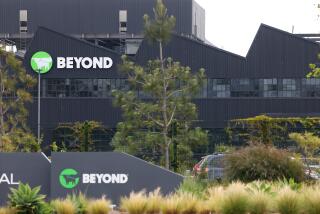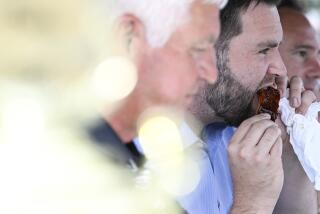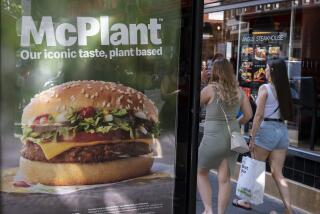Diners Are Finishing Their Vegetables, Asking for More
Some of the new customers at the Blind Faith vegetarian restaurant in Evanston, Ill., sport fur coats.
*
âThatâs very frustrating for me and my staff,â says manager Rob Levin. âBut we donât kick them out. We get a real variety of customers these days.â
Mink-garbed diners may be a disturbing sight to purist vegetarians, who are animal defenders of old. But theyâre a sign of a sea change in vegetarian eating.
Spurred more by concerns for their health than pity for animals, many Americans are becoming part-time vegetarians, gobbling down vegetable brochettes or avocado burritos one day while enjoying their chops another.
âTheyâre not coming out and saying I want to save Bambi,â says Linda Gilbert, president of the Des Moines, Iowa-based research firm HealthFocus Inc. âPeople are getting into it because they want to eat less fat.â
You can see the change on menus, on grocery shelves, at supper tables. Restaurants canât get away without offering meatless entrees. Supermarket sales of imitation meats are booming. Nearly a quarter of the new Nestleâs Lean Cuisine frozen dinners in the last two years have been meatless.
The popularity of such food has become so great that PBS plans the first nationally broadcast vegetarian cooking show in December, with Mollie Katzen, author of such classics as the âMoosewood Cookbook.â
âAs recently as a couple of years ago, people at PBS were nervous about the show being vegetarian. They were saying, should we even use the âvâ word?â she said in an interview. âNow weâre going to use it prominently!â
The revolution in American attitudes toward health and food played a big part in turning vegetarianism from a Cinderella of cuisines to a belle of the table.
Once, bland vegetarian products were found only in health food stores frequented by people seen by the rest of the population as, well, flaky. Moreover, vegetarian foods often depended on cheese and eggs, making them rich and fatty.
But the American obsession with getting fit, along with the discovery that fat is the enemy, transformed vegetarian eating--just at the time that a broader audience was discovering it.
âItâs not like the old days when youâd be eating lettuce and rice, rabbit food,â says Patrick Downey, manager of Angelicaâs Kitchen, a trendy vegetarian restaurant in New York Cityâs East Village.
Angelicaâs dishes up a variety of Asian-inspired meals ranging from vegetable sushi with lemon-ginger sauce to âgarden bowlsâ of Japanese broth laden with seaweed, shiitake mushrooms, ginger and vegetables.
Strict vegetarians are rare. Up to 2 million Americans--1% of the population--completely abstain from meat, poultry or fish, according to a survey by the Baltimore-based Vegetarian Resource Group.
Archer Daniels Midland Co. has sold a veggie burger under the Green Giant label nationally for a year, with results âfar beyond our expectations,â says Larry Cunningham at ADM.
Linda McCartney, wife of the former Beatle, has sold 10 million frozen vegetarian meals--such as âMexican-style stew with Spanish riceâ--since introducing them in 10 U.S. test markets last year.
Sales of imitation meat or poultry products shot from $44 million in 1994 to nearly $65 million in 1995, with the years ending in March, according to the research firm A.C. Nielsen Inc.
âYou donât find food categories that grow like that. Most grow 3% to 5% a year,â says Don Ludemann, manager of strategy and brand development for Green Giant, a Pillsbury Co. brand.
More to Read
Eat your way across L.A.
Get our weekly Tasting Notes newsletter for reviews, news and more.
You may occasionally receive promotional content from the Los Angeles Times.










